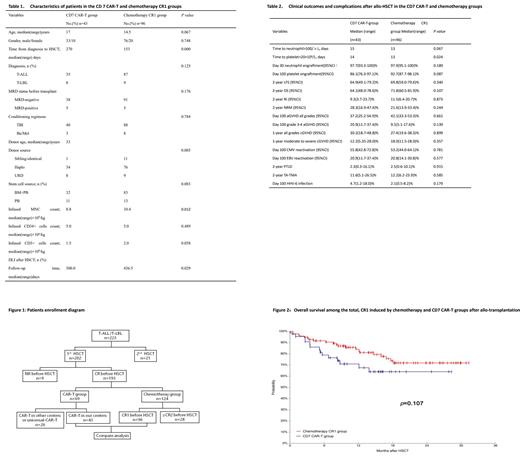Introduction
We have developed a fratricide-resistant CD7 CAR-T cells from bulk T cells transduced with CD7 CAR without gene editing or additional gene transfer, named
naturally selected CD7 CAR-T (NS7CAR-T). NS7 CAR-T therapy has shown a robust complete remission (CR) rate in patients with refractory or relapsed (R/R) T-cell acute lymphoblastic leukemia and T-cell lymphoblastic lymphoma (T-ALL/LBL). Nonetheless, the risk of relapse remains a challenge post-CD7 CAR-T therapy alone, suggesting the potential benefits of consolidation allogeneic hematopoietic stem cell transplantation (allo-HSCT). The question remains whether CD7 CAR-T therapy could increase the incidence of post-transplant complications. Here we conduct a parallel study to compare the safety and efficacy of allo-HSCT in R/R T-ALL/LBL patients who achieved CR with NS7 CAR-T therapy vs those who reached first CR (CR1) using chemotherapy prior to transplantation.
Methods
Between November 2020 and January 2023, a total of 223 consecutive patients with T-ALL/LBL who underwent allo-HSCT at our center were retrospectively analyzed. Patients who met the following criteria were included in this parallel study: 1) underwent the first allo-HSCT in our hospital, 2) achieved CR before transplantation either from NS7CAR-T therapy or CR1 from chemotherapy (Fig. 1). A total of 139 patients met the criteria for analysis and underwent allo-HSCT after achieving CR either from NS7CAR-T therapy (n=43) or chemotherapy (CR1=96). The median patient age at the time of transplantation was 15 years (range: 1-51 years). The median follow-up time was 370 days (2-941 days). CD7 CAR-T patients were from two clinical trials registered at www.clinicaltrials.gov NCT04572308, NCT04916860. Transplant donor types included sibling identical (n=12), haploidentical (n=110), and unrelated donors (n=17). We used total body irradiation (TBI)-based conditioning regimens (n=128) or Busulfan/Melphalan-based regimens (n=11). To prevent graft-versus-host disease (GVHD), we used ATG along with a short-term regimen combining methotrexate, cyclosporine/tacrolimus, and mycophenolate mofetil.
Results
The characteristics of patients from both groups are detailed in Table 1. The median interval between CD7 CAR-T treatment and transplantation was 59 (39-131) days. Within the CAR-T group, 16 patients had primary refractory disease, 18 had relapsed disease and 9 in minimal residual disease (MRD)-positive status in bone marrow before CD7 CAR-T therapy. Prior to CAR-T therapy, 55.8% (24 patients) had extramedullary lesions. In comparing the CAR-T and chemotherapy CR1 groups, we observed no significant differences in long-term efficacy post-allo-HSCT. The 2-year leukemia-free survival (LFS) rates were 64.9 (95% CI, 49.1-79.2)% and 69.8 (95% CI, 59.0-79.6)% (p=0.340); the 2-year overall survival (OS) rates were 64.1 (95%CI, 48.0-78.6)% and 71.8 (95%CI, 60.5-81.9)% (p=0.107); the 2-year relapse incidence (RI) rates were 9.3 (95%CI, 3.7-23.7)% and 11.5 (95%CI, 6.4-20.7)% (p=0.873); and the 2-year non-relapsed mortality (NRM) rates were 28.3 (95% CI, 16.9-47.4)% and 21.6 (95% CI, 13.9-33.4)% (p=0.244), for the CD7 CAR-T and non-CAR-T groups, respectively. The incidence of all grades of acute GVHD (aGVHD) 37.2 (95%CI, 25.2-54.9)% vs. 42.1 (95%CI, 33.3-53.3)% did not significantly differ between the CAR-T and non-CAR-T groups. A trend toward an increased rate but no P significance was observed in Grade 3-4 aGVHD incidence of 20.93 (95%CI, 11.7-37.4)% vs. 9.5 (95%CI, 5.1-17.6)% (p=0.139). One-year incidences of moderate to severe chronic GVHD (cGVHD) were 12.2 (95%CI, 5.4-28.0)% and 18.0 (95%CI, 11.5-28.0)% (p=0.357) in the CD7CAR-T and non-CAR-T groups, respectively (Table 2). No statistically significant differences were detected in the occurrences of transplant-associated thrombotic microangiopathy (TA-TMA), CMV, EBV, and HHV-6 infections between the two groups. Upon analyzing, we found that r/r patients who received allo-HSCT after achieving remission with NS7 CAR-T had a similar OS to CR1 patients (Fig. 2).
Conclusions
Our parallel study showed that T-ALL/LBL patients, who achieved CR via CD7 CAR-T therapy followed by a consolidation allo-HSCT, had similar favorable OS and LFS compared to patients who underwent allo-HSCT in the CR1 state induced by chemotherapy. This was achieved without increasing the incidence of GVHD, infections, or TA-TMA.
Disclosures
No relevant conflicts of interest to declare.


This feature is available to Subscribers Only
Sign In or Create an Account Close Modal